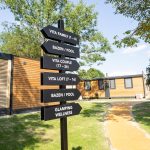International White Cane Safety Day is celebrated every October the 15th since 1964, when the United States of America first proclaimed it. White Cane Safety Day has been officially marked in Croatia since the year 1996. White canes help blind people move quickly and securely on familiar terrain, and ”the cane” has become the ”trademark” for the blind across the world.
In addition, it helps people who can see to notice them, especially when walking through busy traffic. To use the cane correctly, one should go through a course of self-movement where basics in technique and skills, as well as basic traffic rules and areas in which it will be used, are properly taught. From the 1930’s onwards, people started to use canes more frequently, and after the Second World War, they became widely used.
In Croatia, there are 17,979 registered blind and visually impaired people, out of which are more than 6,000 are legally blind. Data from the World Health Organisation suggests that there are about 39 million blind people in the world, and 246 million visually impaired people.
The everyday issues of the blind and the visually impaired are almost unimaginable, from ordering a meal in a restaurant, to buying things in a shop, to walking on the streets, to having access to different institutions. The white cane and modern technology can help a lot in situations like these to offer blind person independence.
On the aforementioned date every year, the public is introduced and educated on the generally incomprehensible problems faced by blind people each and every day. The day is marked with a series of events that aim to improve the quality of life of both blind and visually impaired people.
To mark 2018’s White Cane Safety Day, the Croatian Blind Union organised events in the Typhological Museum. The main topics were the uniqueness of learning books on Croatian Braille script, the importance of early age education of Braille script for blind pupils, and the plethora of other problems blind people are forced to tackle on a daily basis.
The Typhlological Museum, as one of the main institutions providing the same access to people with disabilities as those without them, started to provide exhibitions especially adjusted for blind people. The Museum was founded by Vinko Bek, the first person to begin the formal education of blind children in Zagreb back in 1893.
This institution is considered as the beginning of organised care for blind people. Vinko Bek was the first to adjust the Braille script to Croatian language, the first to collect the items intended for a museum for blind people in Zagreb, and the first who started to publish the journal “Sljepčev prijatelj” (The blind person’s friend). He also promoted the ability of blind people to be an equal part of society and earn their own money.
The museum has a range of activities adapted to the needs of people with disabilities, and all of the museum’s texts are translated into Braille. The museum has permanent exhibition consisting of several parts, the history of the education of the blind in Croatia, the development of the different types of scripts and machines for blind people, and an art gallery which includes works from various blind artists. Visitors can touch all of the sculptures exhibited in the museum. There is also a workshop held as part of the permanent exhibition in which you can learn how to type Braille script and even use the ”dark room”. The dark room provides visitors with a unique and interactive experience consisting of touch, smell, and sound.
This museum is one of the several institutions in Croatia that deals with the non-formal education of blind and visually impaired people. In the same building lies the theatre for the blind and the visually impaired, which is currently celebrating seventy years of existence. In line with its seventieth anniversary, the Croatian Blind Union is offering different programs, and the Croatian library for the blind and visually impaired is offering different types of books in Braille script, as well as audio books.
October the 15th acts as a day to think of the blind and the visually impaired, help them on the streets, or go and see the work done by numerous institutions which help to bring about equality.
SOURCE (text and photos): Typhlological Museum, HZJZ, the Croatian Blind Union








